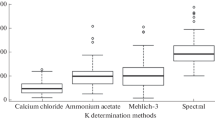Abstract
The present study attempts to quantitatively estimate total potassium content in soil samples collected from different areas of Indian Sundarbans by gamma-spectrometry, exploiting the radiogenic properties of potassium and by wavelength dispersive X-ray fluorescence technique. The elemental K concentration varied in between 2.08 ± 0.05 and 3.46 ± 0.06% in the soil samples. Besides estimation of total potassium, the activity of 40K was also estimated in the same soil samples and found to be in the range of 532 ± 8.9 to 1043 ± 13.2 Bq kg−1.



Similar content being viewed by others
References
Haldar A, Debnath A (2014) Assessment of climate induced soil salinity conditions of Gosaba Island, West Bengal and its influence on local livelihood. In: Singh M, Singh RB, Hassan MI (eds) Climate change and biodiversity: proceedings of the IGU Rohtak conference, vol 1. Springer, Berlin, pp 27–44
Sardans J, Peñuelas J (2015) Potassium: a neglected nutrient in global change. Glob Ecol Biogeogr 24:261–275
Qiu S, Xie J, Zhao S, Xu X, Hou Y, Wang X, Zhou W, He P, Johnston AM, Christie P, Jin J (2014) Long-term effects of potassium fertilization on yield, efficiency, and soil fertility status in a rain-fed maize system in northeast China. Field Crops Res 163:1–9
Savci S (2012) An agricultural pollutant: chemical fertilizer. Int J Environ Sci Dev 3:77–80
Mitran T, Mani PK, Basak N, Mandal B, Mukhopadhyay SK (2014) Soil fertility constraint assessment using spatial nutrient map at three selected villages of coastal Sundarbans. J Soil Salin Water Qual 6:1–8
Bandyopadhyay BK, Sahu GC, Maji B (1998) Status, nature and composition of organic matter in coastal areas. J Indian Soc Soil Sci 19:58–67
Matilal S, Mukherjee BB, Chatterjee N, Gupta MD (1986) Studies on soil and vegetation of mangrove forests of Sunderbans. Indian J Marine Sci 15:181–184
Sarkar SK, Franciscovic-Bilinski S, Bhattacharya A, Saha M, Bilinski H (2004) Levels of elements in the surficial estuarine sediments of the Hugli River, northeast India and their environmental implications. Environ Int 30:1089–1098
Ghosh S, Ram SS, Bakshi M, Chakraborty A, Sudarshan M, Chaudhuri P (2016) Vertical and horizontal variation of elemental contamination in sediments of Hooghly Estuary, India. Mar Pollut Bull 109:539–549
Bakshi M, Ram SS, Ghosh S, Chakraborty A, Sudarshan M, Chaudhuri P (2017) Micro-spatial variation of elemental distribution in estuarine sediment and their accumulation in mangroves of Indian Sundarban. Environ Monit Assess 189:221
Maiti M, Mandal A, Lahiri S (2013) An improved non-destructive method of potassium determination. Appl Radiat Isot 71:37–40
Naskar N, Lahiri S, Chaudhuri P (2016) HF-free microwave assisted dissolution of soil samples for quantitative assessment of potassium. J Indian Chem Soc 93:799–803
Flood RP, Bloemsma MR, Weltje GJ, Barr ID, O’Rourke SM, Turner JN, Orford JD (2016) Compositional data analysis of Holocene sediments from the West Bengal Sundarbans, India: geochemical proxies for grain-size variability in a delta environment. Appl Geochem 75:222–235
Lahiri S, Maiti M, Gangopadhyay K (2016) Tracing ancient silk route by nuclear-analytical technique. J Radioanal Nucl Chem 307:225–228
Naskar N, Lahiri S, Chaudhuri P (2018) Anomalies in quantitative measurement of 40K in natural samples. J Radioanal Nucl Chem 316:709–715
Ahmed OMH, Habbani FI, Mustafa AM, Mohamed EMA, Salih AM, Seedig F (2017) Quality assessment statistic evaluation of X-ray fluorescence via NIST and IAEA standard reference materials. World J Nucl Sci Technol 7:121–128
United nations scientific committee on the effects of atomic radiation report to the general assembly with scientific annexes, v. I. (2000). In: UNSCEAR: sources and effects of ionizing radiation
Banerjee K, Roy Chowdhury M, Sengupta K, Sett S, Mitra A (2012) Influence of anthropogenic and natural factors on the mangrove soil of Indian Sundarbans wetland. Arch Environ Sci 6:80–91
Chatterjee N, Mukhopadhyay R, Mitra D (2015) Decadal changes in shoreline patterns in Sundarbans, India. J Coast Sci 2(2):54–64
Chaudhuri P, Naskar N, Lahiri S (2017) Measurement of background radioactivity in surface soil of Indian Sundarban. J Radioanal Nucl Chem 311:1947–1952
Naskar N, Lahiri S, Chaudhuri P, Srivastava A (2017) Measurement of naturally occurring radioactive material, 238U and 232Th- part-2: optimization of counting time. J Radioanal Nucl Chem 312:161–171
Naskar N, Lahiri S, Chaudhuri P, Srivastava A (2016) Measurement of naturally occurring radioactive material, 238U and 232Th: anomalies in photo-peak selection. J Radioanal Nucl Chem 310:1381–1396
Naskar N, Lahiri S, Chaudhuri P, Srivastava A (2017) Measurement of naturally occurring radioactive materials, 238U and 232Th- part 3: Is efficiency calibration necessary for quantitative measurement of ultra-low level NORM? J Radioanal Nucl Chem 314:507–511
http://www.nndc.bnl.gov/chart. Accessed 02.12.2018
http://mapmaker.nationalgeographic.org/. Accessed 02.12.2018
Acknowledgements
One of the authors, NN would like to thank Somdeep Ghosh of Department of Environmental Science, University of Calcutta for the help in sample collection. NN is also thankful to University Grants Commission (UGC) for providing the necessary fellowship. This work is part of DAE-SINP 12 five-year plan project TULIP (Trace, Ultratrace Analysis and Isotope Production).
Author information
Authors and Affiliations
Corresponding author
Additional information
Publisher's Note
Springer Nature remains neutral with regard to jurisdictional claims in published maps and institutional affiliations.
Rights and permissions
About this article
Cite this article
Naskar, N., Lahiri, S. & Chaudhuri, P. Quantitative estimation of total potassium and 40K in surface soil samples of Indian Sundarbans. J Radioanal Nucl Chem 322, 11–17 (2019). https://doi.org/10.1007/s10967-019-06472-2
Received:
Published:
Issue Date:
DOI: https://doi.org/10.1007/s10967-019-06472-2




